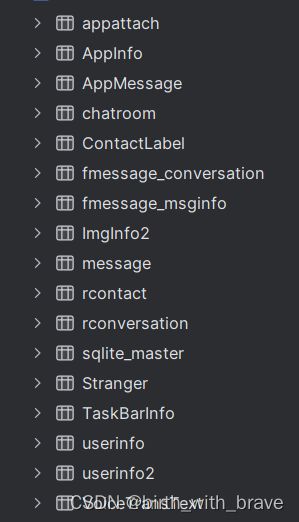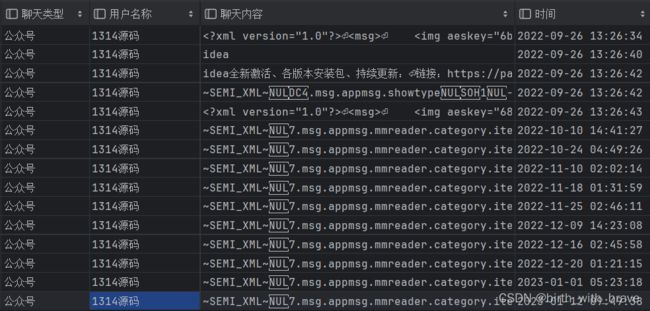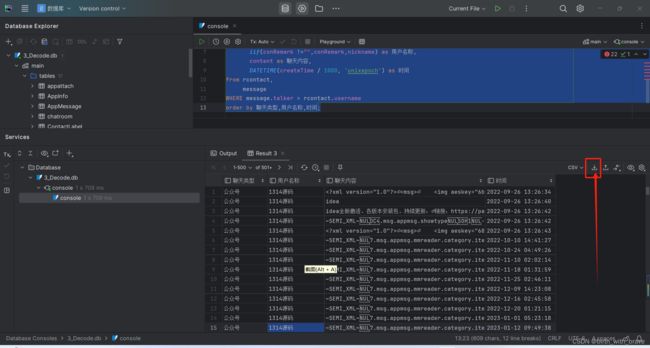- 使用 Redis 实现手机号验证码登陆功能,实际开发中使用 Token 实现登录校验又是如何做的?
程序猿ZhangSir
JavaSpring全家桶微服务javabootstrap开发语言
目录一.使用Redis实现短信登陆功能1.1前言1.2简要分析短信登陆的业务流程1.3代码书写1.4页面展示效果1.5代码优化1.6优化之后的代码二.登录Token2.1JWT简介2.2JWT的使用方式2.3返回token2.4JWT的校验方式一.使用Redis实现短信登陆功能1.1前言对于我们用户来讲,我们在登陆一个APP的时候,有很多种登陆方式,比如"微信扫码"、"手机号登陆"、"支付宝扫码"
- 微信小程序面试内容整理-图片优化
不务正业的猿
面试微信小程序前端微信小程序notepad++小程序面试职场和发展
在微信小程序中,图片优化是提升加载速度、节省网络带宽和提高用户体验的重要步骤。图片通常是小程序页面中的主要资源,合理的图片优化能显著提高小程序的性能,尤其是在用户网络状况较差的情况下。1.选择合适的图片格式不同的图片格式有不同的特点,选择合适的格式能够有效减小图片的大小,同时保证图片质量。
- 程序员不用写代码?DeepSeek这个隐藏功能让我惊掉下巴
后端
凌晨三点半,显示器蓝光映着我的黑眼圈。就在我第18次修改接口文档时,同事老王突然在微信甩来个神秘链接:"用这个,今晚能睡个好觉"。我点开那个叫DeepSeek的页面,没想到接下来的三个小时,我经历了职业生涯最魔幻的加班夜。你见过会自己写测试用例的AI吗?那天晚上,我把项目需求文档往DeepSeek的对话框一扔,它竟然像资深架构师似的,先把需求拆解成模块,接着自动生成了带注释的接口文档。最绝的是,在
- 微信小程序开发:开发者工具安装与配置
暮雨哀尘
微信小程序开发notepad++微信小程序开发语言小程序jsonhtml前端
微信开发者工具安装与配置摘要:本文深入研究了微信开发者工具的安装与配置过程,为开发者提供了详尽的指导。通过对工具的下载、安装步骤,以及开发环境的配置方法进行细致阐述,结合丰富的源代码实例和详细的表格,帮助开发者全面掌握微信开发者工具的使用,提升小程序开发的效率与质量,推动微信小程序生态的持续繁荣。一、引言在移动互联网蓬勃发展的当下,微信作为一款拥有庞大用户群体的社交应用,其小程序生态正呈现出蓬勃发
- 微信小程序:修改提示信息placeholder颜色
25号底片~
微信小程序微信小程序小程序
方法一:使用placeholder-style直接在input或textarea组件中使用placeholder-style属性来设置placeholder的样式。或者:方法二:使用placeholder-class你也可以通过placeholder-class属性来指定一个类名,然后在对应的.wxss文件中定义这个类的样式。wxss.custom-placeholder{color:#999;f
- 【含文档+PPT+源码】基于微信小程序农家乐美食餐厅预约推广系统
编程毕设
微信小程序美食小程序
项目介绍本课程演示的是一款基于微信小程序农家乐美食餐厅预约推广系统,主要针对计算机相关专业的正在做毕设的学生与需要项目实战练习的Java学习者。1.包含:项目源码、项目文档、数据库脚本、软件工具等所有资料2.带你从零开始部署运行本套系统3.该项目附带的源码资料可作为毕设使用该系统功能架构图如下:技术栈说明技术栈:后端:SpringBoot+Vue+ElementUI(后端是前后端分离的)前端:Un
- 能否在编辑器中一键导入Word文档?
2501_90646763
umeditor粘贴wordueditor粘贴wordueditor复制wordueditor上传word图片ueditor导入wordueditor导入pdfueditor导入ppt
要求:开源,免费,技术支持编辑器:百度ueditor前端:vue2,vue3,vue-cli,react,html5用户体验:Ctrl+V快捷键操作功能:导入Word,导入Excel,导入PPT(PowerPoint),导入PDF,复制粘贴word,导入微信公众号内容,web截屏平台:Windows,macOS,Linux,RedHat,CentOS,Ubuntu,中标麒麟,银河麒麟,统信UOS,
- Niushop开源微信商城+小程序商城源码
喵喵源码
微信小程序小程序微信前端
Niushop开源微信单商户V4Niushop单商户V4版,微信商城、小程序商城,支持分销、团购、直播、秒杀、优惠券、自定义页面等众多营销功能,插件化开发,全开源,更适合二开。做最牛、功能最强大的开源商城快速搭建专属店铺,迅速展开线上业务NIUSHOP开源商城B2C单商户V4,功能强大,安全便捷,框架成熟稳定便于扩展,源码100%开源,支持二次开发定制,让企业用更低的成本、更少的人力,更快的速度构
- Vue2 - 详解实现网站使用企业微信二维码扫描登录,企业微信授权第三方网站接入企业微信登陆功能,扫二维码登录后获取用户信息,登录页展示企业微信二维码或iframe新开一页或弹框,解决各种报错登录失败
王二红
+Vue企业微信网站授权企业微信扫码登录最新vue2.jsnuxt2.js如何在新窗口弹出企业微信二维码解决显示报错回调错误无法渲染vue企业微信扫一扫二维码登录
前言如果您需要Vue3版本,请访问这篇文章。在vue2|nuxt2网站开发中,详解实现网页集成使用“企业微信扫一扫登录”功能,用户使用手机企业微信app扫描网站的登录二维码后,获取用户身份信息及号码并完成授权登录教程,新手小白完整流程及示例运行代码,支持多种企业微信二维码“展现方式”,可构造独立窗口登录二维码(iframe一个小弹框网页窗口或浏览器新页签全屏展示)、内嵌登录二维码(放到弹框组件中或
- CAS单点登录-微信企业号单点登录(二十)
悟空_
cas微信企业号单点登录sso
CAS单点登录-微信企业号登录(二十)背景在企业号得开发中,无法避免登录的问题,多个系统前端交互可能会设计到单点登录,若多系统已单点登录,那sso如何支持呢?概述查看企业号开发者接口文档我们看完文档后总结如下:1.企业号接口采用密码认证获取access_token2.企业号认证后通过code以及access_token获取用户信息,并不是两个标准的oauth2认证,也不是通过双方的access_t
- 程序员都在偷偷用的黑科技工具,老板发现后竟主动要求加薪?
后端
上周三凌晨两点,我正对着满屏的SQL报错信息抓耳挠腮。同事老王突然在微信群里甩来一行代码:"试试用DeepSeek分析你的数据库日志。"我半信半疑地复制粘贴,没想到这个看似普通的指令,居然在十秒内就定位到了索引缺失的根源。更魔幻的是,第二天早会上,那个总板着脸的CTO居然在全员面前点名表扬了我的"超强问题排查能力"。这就是DeepSeek最让我着迷的地方——它总能把复杂的代码问题变成幼儿园算术题。
- 微信小程序开发文档
弱水*三千
微信小程序
提示:文章写完后,目录可以自动生成,如何生成可参考右边的帮助文档前言要开发小程序首先得有个官方认可的账号才行注册账号,有了账号接下来就必须有个开发小程序的开发工具开发工具,接下来就可以大显身手敲代码了微信公共平台登录登录第一行代码1.开发工具目录这里先讲解一下后裔wxml,这个文件就是写入网页标签的地方,js就是写入代码的地方,wxss就是写入样式的地方搞明白这些就开始我们的第一行代码.2.数据绑
- uniapp 实现微信小程序电影选座功能
鹤鸣的日常
uni-app微信小程序javascriptvue.js前端小程序
拖动代码/***获取点击或触摸事件对应的座位位置*通过事件对象获取座位的行列信息*@param{Event|TouchEvent}event-点击或触摸事件对象*@returns{Object}返回座位位置对象,包含行(row)和列(col)信息,若未找到有效位置则返回{row:-1,col:-1}*/getSeatPosition(event){//统一处理触摸事件和点击事件//触摸事件时从to
- 从零到一揭秘微信小程序标签切换:tab-item、data-tab 和 bindtap 的奇妙冒险
小丁学Java
微信小程序WxMa微信小程序小程序bindtap
从零到一揭秘微信小程序标签切换:tab-item、data-tab和bindtap的奇妙冒险作者:你的奇妙缘分日期:2025年3月12日标签:微信小程序、WXML、WXSS、JS、前端开发在微信小程序的开发世界里,标签切换(TabSwitching)是一个常见的交互场景。无论是电商列表、任务管理,还是本文中的“比对进程”页面,如何优雅地实现选项卡切换?答案藏在tab-item、data-tab和b
- 微信小程序|系统配送员如何登陆抢单?同城配送、预约服务
惠惠软件
数据恢复专辑微信小程序微信小程序
系统中有多个功能有有配送端,最主要的是同城配送,和预约服务两个功能,首先介绍一下同城配送的配送员登录(扩展的同城配送需要开启)第一步,设置模板消息,配送员通过微信模板消息接收配送信息,需要在平台——微信公众号——模板消息设置(注:已认证服务号才能开通模板消息功能,在公众平台(mp.weixin.qq.com)[功能]-[添加功能插件]-[模板消息]中申请开通所在行业选择:IT科技/互联网|电子商务
- python中 except与 except Exception as e的区别
东木月
pythonpython性能提升python开发语言
python中except与exceptExceptionase的区别1、捕获所有异常使用except#-*-coding:utf-8-*-"""@contact:微信1257309054@file:except与exceptExceptionase的区别.py@time:2024/4/1313:26@author:LDC"""importsysdeffun1():try:sys<
- 如何免费制作景区二维码?
二维码
二维码随处可见,你外出旅游,支付用二维码,到了景区也能见到不少二维码。现在越来越多的景区也开始加入二维码,来代替纸质导览图,还能替代一部分的导游,为游客提供更有互动性的体验。一、景区二维码的应用案例招宝山风景区招宝山风景区推出了“智慧旅游”讲解二维码,游客只需打开微信扫描二维码,便能听到讲解员温柔的解说声,深入了解威远城背后的历史故事,让游客在游览过程中能更好地了解景区的文化内涵,提升了旅游体验。
- 小白怎么入门网络安全?看这篇就够啦!
Hacker_LaoYi
web安全安全
由于我之前写了不少网络安全技术相关的故事文章,不少读者朋友知道我是从事网络安全相关的工作,于是经常有人在微信里问我:我刚入门网络安全,该怎么学?要学哪些东西?有哪些方向?怎么选?不同于Java、C/C++等后端开发岗位有非常明晰的学习路线,网路安全更多是靠自己摸索,要学的东西又杂又多,难成体系。常读我文章的朋友知道,我的文章基本以故事为载体的技术输出为主,很少去谈到职场、面试这些方面的内容。主要是
- Python基础知识---数据与变量、进制转换
银白101
python开发语言
1.1软件开发概述(1)软件定义定义:是指有一系列按照特定顺序组织的计算机数据与指令的集合。程序=数据+指令程序=数据结构+算法软件的分类:系统软件:主要负责管理操作计算机底层的硬件,为用户提供一个操作的界面,为用户提供最基本的计算机功能WindowsLinuxMACAndroidIOSHarmonyOS应用软件:主要负责处理某一特殊领域功能的软件:微信、陌陌、Soul、网易云音乐、支付宝、Off
- 小程序租赁系统智能风控与多端适配实践
红点租赁系统开发
其他
内容概要当你的手机里塞满各类小程序时,小程序租赁系统正悄悄把"租东西"这件事变成科技界的"变形金刚"。这套系统不仅打通了支付宝、微信、APP三端的数据壁垒,还像给每个用户装上了信用扫描仪——央行征信评估叠加芝麻信用免押,让押金争议直接退场。更妙的是,区块链存证技术给每笔交易贴上防伪标签,就算遇到纠纷,司法存证模块也能让证据链硬得像块钢板。如果你还在纠结"选安卓还是iOS",这套系统早就在抖音、PC
- Bluetooth Profile Specification之(AVRCP篇)5.0 AVRCP简介
心跳包
蓝牙篇之蓝牙协议规范蓝牙
蓝牙篇之BluetoothProfileSpecification深入详解汇总目录1.什么是AVRCP?2.协议栈模型关注文末微信公众号,回复【蓝牙规范】,即可获取AVRCP英文版协议。1.什么是AVRCP?字面意思音频/视频远程控制协议。AVRCP定义的命令和信息是通过AVCTP通过传输出去的。AVRCP协议不处理音视频流,支持这个协议的设备可以通过A2DP来分发流媒体数据。1.5版本到1.6版
- 芯片制造、汽车制造行业网站,如何用插件增强富文本编辑器的WORD粘贴功能?
全武凌(荆门泽优)
金融编辑器wordumeditor粘贴wordueditor粘贴wordueditor复制wordueditor上传word图片
要求:开源,免费,技术支持编辑器:百度ueditor前端:vue2,vue3,vue-cli,react,html5用户体验:Ctrl+V快捷键操作功能:导入Word,导入Excel,导入PPT(PowerPoint),导入PDF,复制粘贴word,导入微信公众号内容,web截屏平台:Windows,macOS,Linux,RedHat,CentOS,Ubuntu,中标麒麟,银河麒麟,统信UOS,
- 金融行业网页编辑器对WORD图文混排有哪些特殊需求?
全武凌(荆门泽优)
金融编辑器wordumeditor粘贴wordueditor粘贴wordueditor复制wordueditor上传word图片
要求:开源,免费,技术支持编辑器:百度ueditor前端:vue2,vue3,vue-cli,react,html5用户体验:Ctrl+V快捷键操作功能:导入Word,导入Excel,导入PPT(PowerPoint),导入PDF,复制粘贴word,导入微信公众号内容,web截屏平台:Windows,macOS,Linux,RedHat,CentOS,Ubuntu,中标麒麟,银河麒麟,统信UOS,
- HTML编辑器CKEDITOR支持哪些格式的WORD内容导入?
2501_90699640
html编辑器wordckeditor粘贴wordckeditor导入wordckeditor导入pdfckeditor导入ppt
要求:开源,免费,技术支持编辑器:ckeditor前端:vue2,vue3.vue-cli后端:asp,java,jsp,springboot,php,asp.net,.netcore功能:导入Word,导入Excel,导入PPT(PowerPoint),导入PDF,复制粘贴word,导入微信公众号内容,web截屏平台:Windows,macOS,Linux,RedHat,Ubuntu,CentO
- 金融行业Vue应用如何利用wangEditor实现WORD文档高效上传?
2501_90699640
金融vue.jswordumeditor粘贴wordueditor粘贴wordueditor复制wordueditor上传word图片
要求:开源,免费,技术支持编辑器:百度ueditor前端:vue2,vue3,vue-cli,react,html5用户体验:Ctrl+V快捷键操作功能:导入Word,导入Excel,导入PPT(PowerPoint),导入PDF,复制粘贴word,导入微信公众号内容,web截屏平台:Windows,macOS,Linux,RedHat,CentOS,Ubuntu,中标麒麟,银河麒麟,统信UOS,
- B/S vs C/S架构:技术选型与实战对比
码农阿豪@新空间
包罗万象c语言架构开发语言
个人名片作者简介:java领域优质创作者个人主页:码农阿豪工作室:新空间代码工作室(提供各种软件服务)个人邮箱:[
[email protected]]个人微信:15279484656个人导航网站:www.forff.top座右铭:总有人要赢。为什么不能是我呢?专栏导航:码农阿豪系列专栏导航面试专栏:收集了java相关高频面试题,面试实战总结️Spring5系列专栏:整理了Spring5重要知识点与
- uni-app 小程序项目四 封装 radio组件、NumberBox组件以及数据问题、滑动删除组件、收货地址组件以及授权问题、结算区域
Hyman-ya
uni-app小程序项目uni-app
购物车页面1.0创建购物车页面的编译模式打开微信开发者工具,点击工具栏上的“编译模式”下拉菜单,选择“添加编译模式”:勾选“启动页面的路径”之后,点击“确定”按钮,新增购物车页面的编译模式:1.1商品列表区域1.11渲染购物车商品列表的标题区域定义如下的UI结构:购物车美化样式:.cart-title{height:40px;display:flex;align-items:center;font
- uniapp移动端图片比较器组件,仿英伟达官网rtx光追图片比较器功能
独断万古的伊莉雅
uni-appjavascript前端组件
组件下载地址:https://ext.dcloud.net.cn/plugin?id=22609已测试h5和微信小程序,理论支持全平台亮点:简单易用使用js计算而不是resize属性,定制化程度更高组件挂在后可播放指示线动画,提示用户可以拖拽比较图片左右下角可配置文字,且指引线距离文字过近时文字会变透明使用示例RTXOFF效果示例:
- MySQL探秘之旅:总体架构介绍
互联网全栈架构
mysql架构数据库
欢迎关注微信公众号:互联网全栈架构自从《吃透Redis系列》阅读量屡创新高之后,更加坚定了创作技术系列文章的决心,从而让朋友们获得更加体系化的知识。当然,这是一件非常不容易的事情,让每篇文章都能单独成篇且质量上乘,同时,把它们连起来以后又能构成一个体系,着实困难。但不管如何,我觉得这样的方向和做法没有问题,应该会受到大家的欢迎,那就迎难而上。上次做了一个统计,相对来说,大家对于MySQL的文章比较
- 从零开始开发微信小程序:全面指南
百态老人
经验分享微信小程序小程序
学习制作微信小程序,希望通过这次学习能够实现跨平台的统一开发,从而提高自己的编程和开发能力。第一部分需要事先准备的工具和环境:一、工具:1、微信开发者工具:用于开发、调试和预览微信小程序。微信开发者工具是专门为微信小程序开发提供的集成开发环境(IDE)。它的主要功能包括:1)开发:可以编写、编辑、管理小程序的代码,支持多种编程语言和框架(如JavaScript、TypeScript、WXML、WX
- 开发者关心的那些事
圣子足道
ios游戏编程apple支付
我要在app里添加IAP,必须要注册自己的产品标识符(product identifiers)。产品标识符是什么?
产品标识符(Product Identifiers)是一串字符串,它用来识别你在应用内贩卖的每件商品。App Store用产品标识符来检索产品信息,标识符只能包含大小写字母(A-Z)、数字(0-9)、下划线(-)、以及圆点(.)。你可以任意排列这些元素,但我们建议你创建标识符时使用
- 负载均衡器技术Nginx和F5的优缺点对比
bijian1013
nginxF5
对于数据流量过大的网络中,往往单一设备无法承担,需要多台设备进行数据分流,而负载均衡器就是用来将数据分流到多台设备的一个转发器。
目前有许多不同的负载均衡技术用以满足不同的应用需求,如软/硬件负载均衡、本地/全局负载均衡、更高
- LeetCode[Math] - #9 Palindrome Number
Cwind
javaAlgorithm题解LeetCodeMath
原题链接:#9 Palindrome Number
要求:
判断一个整数是否是回文数,不要使用额外的存储空间
难度:简单
分析:
题目限制不允许使用额外的存储空间应指不允许使用O(n)的内存空间,O(1)的内存用于存储中间结果是可以接受的。于是考虑将该整型数反转,然后与原数字进行比较。
注:没有看到有关负数是否可以是回文数的明确结论,例如
- 画图板的基本实现
15700786134
画图板
要实现画图板的基本功能,除了在qq登陆界面中用到的组件和方法外,还需要添加鼠标监听器,和接口实现。
首先,需要显示一个JFrame界面:
public class DrameFrame extends JFrame { //显示
- linux的ps命令
被触发
linux
Linux中的ps命令是Process Status的缩写。ps命令用来列出系统中当前运行的那些进程。ps命令列出的是当前那些进程的快照,就是执行ps命令的那个时刻的那些进程,如果想要动态的显示进程信息,就可以使用top命令。
要对进程进行监测和控制,首先必须要了解当前进程的情况,也就是需要查看当前进程,而 ps 命令就是最基本同时也是非常强大的进程查看命令。使用该命令可以确定有哪些进程正在运行
- Android 音乐播放器 下一曲 连续跳几首歌
肆无忌惮_
android
最近在写安卓音乐播放器的时候遇到个问题。在MediaPlayer播放结束时会回调
player.setOnCompletionListener(new OnCompletionListener() {
@Override
public void onCompletion(MediaPlayer mp) {
mp.reset();
Log.i("H
- java导出txt文件的例子
知了ing
javaservlet
代码很简单就一个servlet,如下:
package com.eastcom.servlet;
import java.io.BufferedOutputStream;
import java.io.IOException;
import java.net.URLEncoder;
import java.sql.Connection;
import java.sql.Resu
- Scala stack试玩, 提高第三方依赖下载速度
矮蛋蛋
scalasbt
原文地址:
http://segmentfault.com/a/1190000002894524
sbt下载速度实在是惨不忍睹, 需要做些配置优化
下载typesafe离线包, 保存为ivy本地库
wget http://downloads.typesafe.com/typesafe-activator/1.3.4/typesafe-activator-1.3.4.zip
解压r
- phantomjs安装(linux,附带环境变量设置) ,以及casperjs安装。
alleni123
linuxspider
1. 首先从官网
http://phantomjs.org/下载phantomjs压缩包,解压缩到/root/phantomjs文件夹。
2. 安装依赖
sudo yum install fontconfig freetype libfreetype.so.6 libfontconfig.so.1 libstdc++.so.6
3. 配置环境变量
vi /etc/profil
- JAVA IO FileInputStream和FileOutputStream,字节流的打包输出
百合不是茶
java核心思想JAVA IO操作字节流
在程序设计语言中,数据的保存是基本,如果某程序语言不能保存数据那么该语言是不可能存在的,JAVA是当今最流行的面向对象设计语言之一,在保存数据中也有自己独特的一面,字节流和字符流
1,字节流是由字节构成的,字符流是由字符构成的 字节流和字符流都是继承的InputStream和OutPutStream ,java中两种最基本的就是字节流和字符流
类 FileInputStream
- Spring基础实例(依赖注入和控制反转)
bijian1013
spring
前提条件:在http://www.springsource.org/download网站上下载Spring框架,并将spring.jar、log4j-1.2.15.jar、commons-logging.jar加载至工程1.武器接口
package com.bijian.spring.base3;
public interface Weapon {
void kil
- HR看重的十大技能
bijian1013
提升能力HR成长
一个人掌握何种技能取决于他的兴趣、能力和聪明程度,也取决于他所能支配的资源以及制定的事业目标,拥有过硬技能的人有更多的工作机会。但是,由于经济发展前景不确定,掌握对你的事业有所帮助的技能显得尤为重要。以下是最受雇主欢迎的十种技能。 一、解决问题的能力 每天,我们都要在生活和工作中解决一些综合性的问题。那些能够发现问题、解决问题并迅速作出有效决
- 【Thrift一】Thrift编译安装
bit1129
thrift
什么是Thrift
The Apache Thrift software framework, for scalable cross-language services development, combines a software stack with a code generation engine to build services that work efficiently and s
- 【Avro三】Hadoop MapReduce读写Avro文件
bit1129
mapreduce
Avro是Doug Cutting(此人绝对是神一般的存在)牵头开发的。 开发之初就是围绕着完善Hadoop生态系统的数据处理而开展的(使用Avro作为Hadoop MapReduce需要处理数据序列化和反序列化的场景),因此Hadoop MapReduce集成Avro也就是自然而然的事情。
这个例子是一个简单的Hadoop MapReduce读取Avro格式的源文件进行计数统计,然后将计算结果
- nginx定制500,502,503,504页面
ronin47
nginx 错误显示
server {
listen 80;
error_page 500/500.html;
error_page 502/502.html;
error_page 503/503.html;
error_page 504/504.html;
location /test {return502;}}
配置很简单,和配
- java-1.二叉查找树转为双向链表
bylijinnan
二叉查找树
import java.util.ArrayList;
import java.util.List;
public class BSTreeToLinkedList {
/*
把二元查找树转变成排序的双向链表
题目:
输入一棵二元查找树,将该二元查找树转换成一个排序的双向链表。
要求不能创建任何新的结点,只调整指针的指向。
10
/ \
6 14
/ \
- Netty源码学习-HTTP-tunnel
bylijinnan
javanetty
Netty关于HTTP tunnel的说明:
http://docs.jboss.org/netty/3.2/api/org/jboss/netty/channel/socket/http/package-summary.html#package_description
这个说明有点太简略了
一个完整的例子在这里:
https://github.com/bylijinnan
- JSONUtil.serialize(map)和JSON.toJSONString(map)的区别
coder_xpf
jqueryjsonmapval()
JSONUtil.serialize(map)和JSON.toJSONString(map)的区别
数据库查询出来的map有一个字段为空
通过System.out.println()输出 JSONUtil.serialize(map): {"one":"1","two":"nul
- Hibernate缓存总结
cuishikuan
开源sshjavawebhibernate缓存三大框架
一、为什么要用Hibernate缓存?
Hibernate是一个持久层框架,经常访问物理数据库。
为了降低应用程序对物理数据源访问的频次,从而提高应用程序的运行性能。
缓存内的数据是对物理数据源中的数据的复制,应用程序在运行时从缓存读写数据,在特定的时刻或事件会同步缓存和物理数据源的数据。
二、Hibernate缓存原理是怎样的?
Hibernate缓存包括两大类:Hib
- CentOs6
dalan_123
centos
首先su - 切换到root下面1、首先要先安装GCC GCC-C++ Openssl等以来模块:yum -y install make gcc gcc-c++ kernel-devel m4 ncurses-devel openssl-devel2、再安装ncurses模块yum -y install ncurses-develyum install ncurses-devel3、下载Erang
- 10款用 jquery 实现滚动条至页面底端自动加载数据效果
dcj3sjt126com
JavaScript
无限滚动自动翻页可以说是web2.0时代的一项堪称伟大的技术,它让我们在浏览页面的时候只需要把滚动条拉到网页底部就能自动显示下一页的结果,改变了一直以来只能通过点击下一页来翻页这种常规做法。
无限滚动自动翻页技术的鼻祖是微博的先驱:推特(twitter),后来必应图片搜索、谷歌图片搜索、google reader、箱包批发网等纷纷抄袭了这一项技术,于是靠滚动浏览器滚动条
- ImageButton去边框&Button或者ImageButton的背景透明
dcj3sjt126com
imagebutton
在ImageButton中载入图片后,很多人会觉得有图片周围的白边会影响到美观,其实解决这个问题有两种方法
一种方法是将ImageButton的背景改为所需要的图片。如:android:background="@drawable/XXX"
第二种方法就是将ImageButton背景改为透明,这个方法更常用
在XML里;
<ImageBut
- JSP之c:foreach
eksliang
jspforearch
原文出自:http://www.cnblogs.com/draem0507/archive/2012/09/24/2699745.html
<c:forEach>标签用于通用数据循环,它有以下属性 属 性 描 述 是否必须 缺省值 items 进行循环的项目 否 无 begin 开始条件 否 0 end 结束条件 否 集合中的最后一个项目 step 步长 否 1
- Android实现主动连接蓝牙耳机
gqdy365
android
在Android程序中可以实现自动扫描蓝牙、配对蓝牙、建立数据通道。蓝牙分不同类型,这篇文字只讨论如何与蓝牙耳机连接。
大致可以分三步:
一、扫描蓝牙设备:
1、注册并监听广播:
BluetoothAdapter.ACTION_DISCOVERY_STARTED
BluetoothDevice.ACTION_FOUND
BluetoothAdapter.ACTION_DIS
- android学习轨迹之四:org.json.JSONException: No value for
hyz301
json
org.json.JSONException: No value for items
在JSON解析中会遇到一种错误,很常见的错误
06-21 12:19:08.714 2098-2127/com.jikexueyuan.secret I/System.out﹕ Result:{"status":1,"page":1,&
- 干货分享:从零开始学编程 系列汇总
justjavac
编程
程序员总爱重新发明轮子,于是做了要给轮子汇总。
从零开始写个编译器吧系列 (知乎专栏)
从零开始写一个简单的操作系统 (伯乐在线)
从零开始写JavaScript框架 (图灵社区)
从零开始写jQuery框架 (蓝色理想 )
从零开始nodejs系列文章 (粉丝日志)
从零开始编写网络游戏
- jquery-autocomplete 使用手册
macroli
jqueryAjax脚本
jquery-autocomplete学习
一、用前必备
官方网站:http://bassistance.de/jquery-plugins/jquery-plugin-autocomplete/
当前版本:1.1
需要JQuery版本:1.2.6
二、使用
<script src="./jquery-1.3.2.js" type="text/ja
- PLSQL-Developer或者Navicat等工具连接远程oracle数据库的详细配置以及数据库编码的修改
超声波
oracleplsql
在服务器上将Oracle安装好之后接下来要做的就是通过本地机器来远程连接服务器端的oracle数据库,常用的客户端连接工具就是PLSQL-Developer或者Navicat这些工具了。刚开始也是各种报错,什么TNS:no listener;TNS:lost connection;TNS:target hosts...花了一天的时间终于让PLSQL-Developer和Navicat等这些客户
- 数据仓库数据模型之:极限存储--历史拉链表
superlxw1234
极限存储数据仓库数据模型拉链历史表
在数据仓库的数据模型设计过程中,经常会遇到这样的需求:
1. 数据量比较大; 2. 表中的部分字段会被update,如用户的地址,产品的描述信息,订单的状态等等; 3. 需要查看某一个时间点或者时间段的历史快照信息,比如,查看某一个订单在历史某一个时间点的状态, 比如,查看某一个用户在过去某一段时间内,更新过几次等等; 4. 变化的比例和频率不是很大,比如,总共有10
- 10点睛Spring MVC4.1-全局异常处理
wiselyman
spring mvc
10.1 全局异常处理
使用@ControllerAdvice注解来实现全局异常处理;
使用@ControllerAdvice的属性缩小处理范围
10.2 演示
演示控制器
package com.wisely.web;
import org.springframework.stereotype.Controller;
import org.spring






